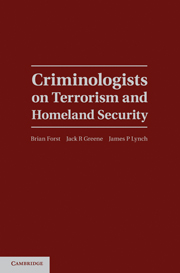Book contents
- Frontmatter
- Contents
- About the Authors
- Preface
- 1 Introduction and Overview
- PART I NATURE OF THE PROBLEM
- 2 Manifestations of Aggression
- 3 The Etiology of Terrorism
- 4 Balancing Counterterrorism Strategies
- 5 Gangs, Crime, and Terrorism
- 6 Women Terrorists
- PART II STRATEGIES FOR INTERVENTION
- PART III THINKING ABOUT TOMORROW
- Index
- References
6 - Women Terrorists
Published online by Cambridge University Press: 04 February 2011
- Frontmatter
- Contents
- About the Authors
- Preface
- 1 Introduction and Overview
- PART I NATURE OF THE PROBLEM
- 2 Manifestations of Aggression
- 3 The Etiology of Terrorism
- 4 Balancing Counterterrorism Strategies
- 5 Gangs, Crime, and Terrorism
- 6 Women Terrorists
- PART II STRATEGIES FOR INTERVENTION
- PART III THINKING ABOUT TOMORROW
- Index
- References
Summary
INTRODUCTION
This chapter examines evidence from women involved in terrorist organizations that are currently active. We examine the roles women play in existing terrorist groups and the common demographic characteristics of the women who join these groups. We also examine the motives women have for joining terrorist organizations and whether those motives differ by type of terrorist group. The evidence demonstrates that women join terrorist groups for myriad reasons, including marginalization by society, individual choice, avengement of another's death, recruitment by the organizations, and serving as pawns in a man's game. Charles Townshend, writing in Terrorism, reports:
Something like a quarter of the Russian terrorists of the 19th century were women; a proportion possibly exceeded among the German and American terrorists of the 1970s. A full third of the Communist Organized for the Liberation of the Proletariat (COLP) in Italy were women, and 31 percent of that nation's Bridate Rossi (Red Brigades). (Townshend 2002)
In an earlier paper published in 1980 that examined the historical role of women in terrorist organizations, we found that women's involvement in such organizations was not a side effect of the women's liberation movement. Rather, the evidence suggested that one of the unintended consequences of women's involvement in these organizations is that their involvement weakened traditional customs and sex roles (Benson, Evans, and Simon 1980).
Like the 1980 piece, this chapter is limited largely to anecdotal evidence about female terrorists, which creates only a thin foundation for sociological generalization.
- Type
- Chapter
- Information
- Criminologists on Terrorism and Homeland Security , pp. 113 - 126Publisher: Cambridge University PressPrint publication year: 2011
References
- 1
- Cited by



